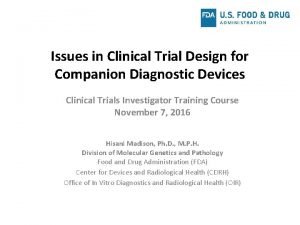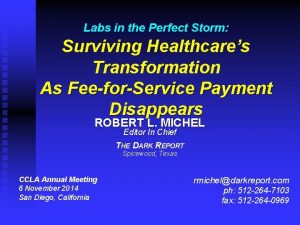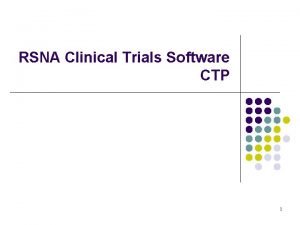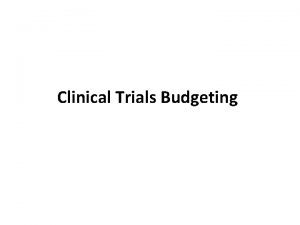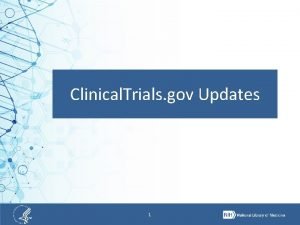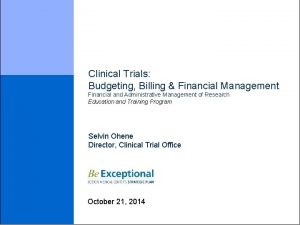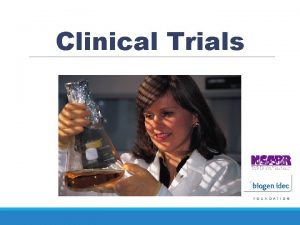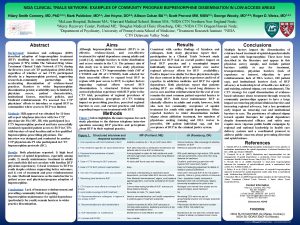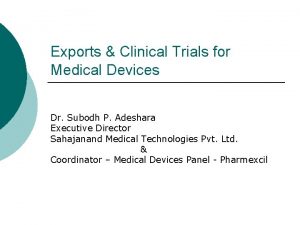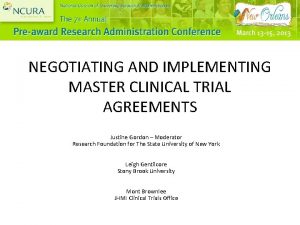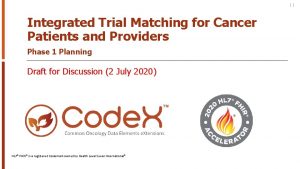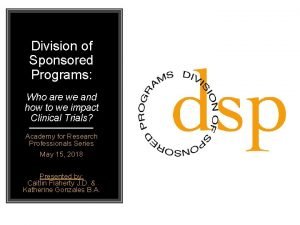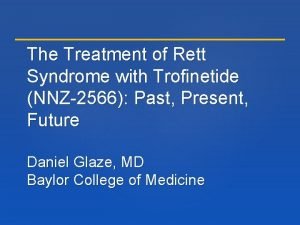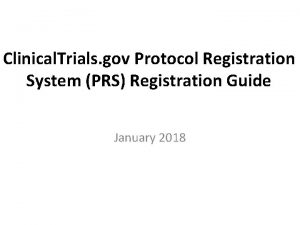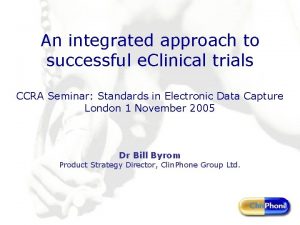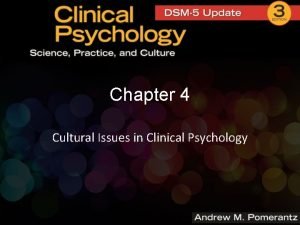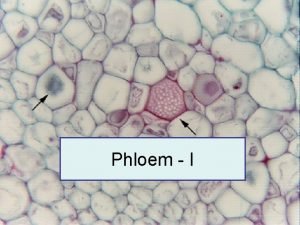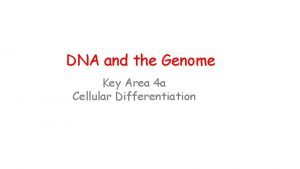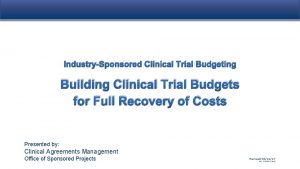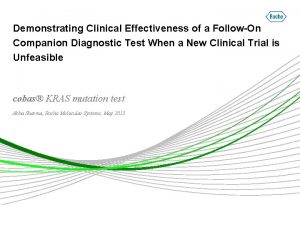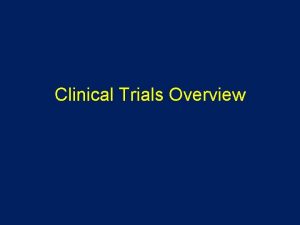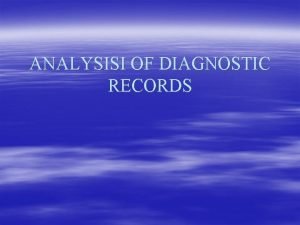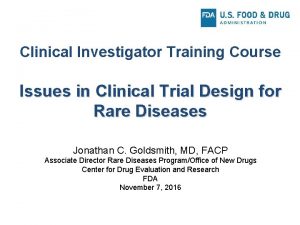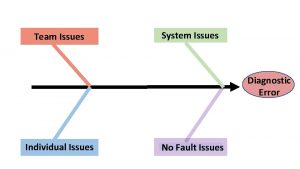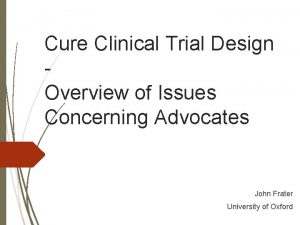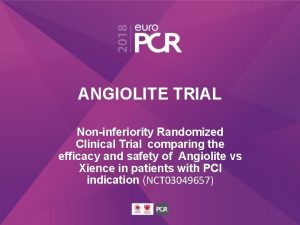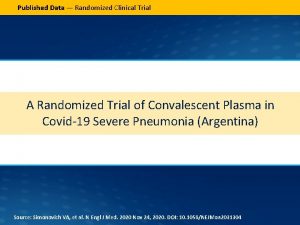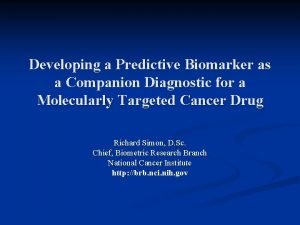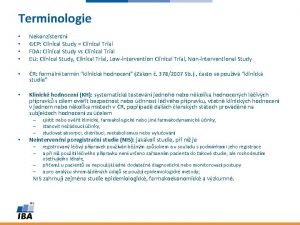Issues in Clinical Trial Design for Companion Diagnostic












































- Slides: 44

Issues in Clinical Trial Design for Companion Diagnostic Devices Clinical Trials Investigator Training Course November 7, 2016 Hisani Madison, Ph. D. , M. P. H. Division of Molecular Genetics and Pathology Food and Drug Administration (FDA) Center for Devices and Radiological Health (CDRH) Office of In Vitro Diagnostics and Radiological Health (OIR)

Presentation Overview • Overview of Regulation of In Vitro Diagnostic Devices (IVDs) • Key Regulatory Questions: Drug/Device Codevelopment ‒ Challenges & Solutions • Useful Tips & Tools www. fda. gov 2

The contents of this presentation are for discussion and summary purposes only and do not describe the full extent of requirements applicable to devices, including IVDs and Companion Diagnostic Devices. Please see the Federal Food, Drug, and Cosmetic Act and 21 CFR Subchapter H for requirements applicable to medical devices. www. fda. gov 3

Definition: In Vitro Diagnostic Device “Reagents, instruments, and systems intended for use in the diagnosis of disease or other conditions, including a determination of the state of health, in order to cure, mitigate, treat, or prevent disease or its sequelae. … for use in the collection, preparation, and examination of specimens from the human body. ” [21 CFR 809. 3] www. fda. gov 4

Human Subject Regulations Definition of a “Human Subject” • A human who participates in an investigation, either as a recipient of the test article or as a control. Includes both persons in normal health and patients. • Subject is an individual on whom or on whose specimen an investigational device is used. www. fda. gov 5

FDA Human Subject Protection Regulations • 21 CFR Part 50: Protection of Human Subjects and Informed Consent • 21 CFR Part 54: Financial Disclosure of Investigators • 21 CFR Part 56: Institutional Review Boards • 21 CFR 812: Investigational Device Exemption – Includes disqualification of investigators – Applies to all FDA clinical investigations www. fda. gov 6

Premarket Risk Based Regulation • Class I: common, low risk devices • e. g. , mass spectrometer for clinical use • Most exempt from premarket submission • General controls • Class II: more complex, moderate risk • e. g. , prognosis, monitoring in already diagnosed cancer patients • Premarket Notification [510(k)] • General & Special controls • Class III: most complex, high risk • e. g. , cancer diagnosis or screening • Premarket Application [PMA] • Safety, effectiveness www. fda. gov 7

Basis of Premarket Device Review: Safety and Effectiveness • Safety – Are there reasonable assurances, based on valid scientific evidence that probable benefits to health from use of the device outweigh any probable risks? [860. 7(d)(1)] • Effectiveness – Is there reasonable assurance based on valid scientific evidence that the use of the device in the target population will provide clinically significant results? [860. 7(e)(1)] www. fda. gov 8

FDA Review: Basic Components of IVD Submission • • Intended use/indications for use Device description (platform, software) Pre-analytical performance Analytical performance Clinical performance Instrumentation, software validation (as applicable) Labeling (package insert) Manufacturing, BIMO www. fda. gov 9

Drug/Device Codevelopment: Key Regulatory Questions • Will an IDE be required? • If the drug development program is based on a biomarker, will the test for the biomarker result in a companion diagnostic device? • Does the companion diagnostic device have adequate performance data to be approved contemporaneously with the drug? • Will a bridging study be required? www. fda. gov 10

Drug/Device Codevelopment: Key Regulatory Questions • Will an IDE be required? • If the drug development program is based on a biomarker, will the test for the biomarker result in a companion diagnostic device? • Does the companion diagnostic device have adequate performance data to be approved contemporaneously with the drug? • Will a bridging study be required? www. fda. gov 11

Investigational Device Exemption www. fda. gov http: //www. fda. gov/Medical. Devices/Device. Regulationand. Guidance/Howt o. Market. Your. Device/Investigational. Device. Exemption. IDE/ucm 162453. htm 12

Investigational Use of tests: IDEs and INDs • Sponsors of therapeutic product trials that incorporate an investigational test must consider regulations that pertain to both drugs and devices. • Exemptions from premarket approval requirements for new drugs and devices. • Investigational Device Exemption (IDE) regulation (21 CFR 812) • Investigational New Drug (IND) regulation (21 CFR 312) • IDE and IND regulations have different requirements! www. fda. gov 13

Key Regulatory Questions: Is an IDE needed? • If a diagnostic is used to identify a biomarker in a drug trial, then an Investigational Device Exemption (IDE) may be needed (if the diagnostic is not already FDA cleared or approved for the intended use). • FDA approval of IDE application exempts device from premarket clearance/approval requirement when used in the investigational setting. • IDE requirement is based on risk to patients – does the use of the test result pose a significant risk or a non-significant risk? • Submit risk assessment pre-submission to CDRH to determine if an IDE is needed for your diagnostic. www. fda. gov 14

Assessing Risk 1. Will use of the investigational test results lead to some trial subjects foregoing or delaying a treatment that is known to be effective? 2. Will use of the investigational test results expose trial subjects to safety risks (e. g. , adverse events from the experimental therapy) that (in some “net” sense) exceed the risks encountered with control therapies or non-trial standard of care? 3. Is it likely, based on a priori information about the investigational therapy, that incorrect test results would degrade the safety or efficacy of subjects’ treatment? 4. Does specimen acquisition, done for investigational testing and outside the standard of care, require an invasive sampling procedure that presents significant risk? www. fda. gov 15

What’s in an IDE Application? • • Detailed in 21 CFR 812. 20 Administrative elements Report of prior investigations Investigational plan • Purpose • Protocol • Risk analysis • Description of device • Monitoring procedures www. fda. gov • Labeling • Consent materials • IRB information • Other institutions • Additional records and reports 16

Drug/Device Codevelopment: Key Regulatory Questions • Will an IDE be required? • If the drug development program is based on a biomarker, will the test for the biomarker result in a companion diagnostic device? • Does the companion diagnostic device have adequate performance data to be approved contemporaneously with the drug? • Will a bridging study be required? www. fda. gov 17

Key Regulatory Questions: Is my test a CDx? • Will the test for the biomarker result in a companion diagnostic device? • Companion diagnostic requirement decision made by drug/biologic review division – [CDER/CBER]; device review center (CDRH) provides insight • Is there adequate evidence of clinical activity of the drug in the biomarker positive population identified by the companion diagnostic? • Is the companion diagnostic essential for the safe and effective use of the corresponding therapeutic product? www. fda. gov 18

IVDs: Companion Diagnostics • Companion diagnostics are a subset of IVDs. • An IVD companion diagnostic device is an in vitro diagnostic device that provides information that is essential for the safe and effective use of a corresponding therapeutic product. • If the safe and effective use of therapeutic product requires a particular test result, that test is a companion diagnostic. • Drugs and their companion tests refer to each other in their labels. • Guidance on In Vitro Companion Diagnostic Devices. http: //www. fda. gov/downloads/Medical. Devices/Device. Regul ationand. Guidance/Guidance. Documents/UCM 262327. pdf www. fda. gov 19

Companion Diagnostics • Tests required to determine whether a specific drug should or should not be administered to a patient • Test used for patient selection into therapeutic trial • Clinical validation of test comes from a successful drug trial • Problems can arise when the final test intended for marketing is not the one used to screen patients for the trial – Prescreening – Test changes – Missing outcome data in clinical trial assay (CTA) negative population www. fda. gov 20

Codevelopment: Therapeutic + IVD CDRH IVD Sponsor Therapeutic Sponsor CDER www. fda. gov CBER 21

Codevelopment • The development of paired therapeutic products and diagnostic devices with interdependent uses (e. g. , a drug and a companion diagnostic). • Biomarker discovery and test development can occur anytime during the drug development process. • Safety and efficacy of the new drug and new diagnostic are typically demonstrated in the same clinical trial. • From a regulatory perspective, the goal is simultaneous approval of the drug and diagnostic. IND Basic research Lead optimization Preclinical development Clinical development Phase III FDA filing/approval IDE Biomarker discovery www. fda. gov Assay development Assay validation Clinical validation FDA filing/approval 22

New! DR AF T! http: //www. fda. gov/ucm/groups/fdagov-public/@fdagov-meddevgen/documents/document/ucm 510824. pdf 23

Codevelopment: Benefits & Challenges Benefits Challenges • For pharmaceutical companies: • May not be adequate data early on to determine the best biomarker to measure; whether test needed – Potential for optimum patient population and smaller future trials – Improved drug effect if marker effective • For diagnostic companies: – New type of diagnostic claim – Well characterized subjects – Extensive follow-up www. fda. gov • Appropriate statistics (may allow for e. g. , adaptive trial design if drug not effective in the general population) • Test used in drug trials not the marketed version (platform change) • Appropriate storage of clinical trial samples; IRB, IC 24

Drug/Device Codevelopment: Key Regulatory Questions • Will an IDE be required? • If the drug development program is based on a biomarker, will the test for the biomarker result in a companion diagnostic device? • Does the companion diagnostic device have adequate performance data to be approved contemporaneously with the drug? • Will a bridging study be required? www. fda. gov 25

Key Regulatory Questions: Is my device performance adequate? Does the companion diagnostic device have adequate performance data to be approved contemporaneously with the drug? Analytical Performance Validation • Performed using procured specimens from the intended use population (exception for rare mutations) • Critical performance characteristics should be assessed before using test in trial • Important to assess analytical performance at the clinical decision point (cut-off) Clinical Performance Validation • Supported by the results of the drug trial when companion diagnostic device is used to test specimens and identify patients eligible for the trial www. fda. gov 26

Intended Use of the IVD “Intended Use”-driving force of the scientific review • Understanding : Integration of disease(s)/condition(s). Integration of patient clinical management and public health (surveillance) – Who will be tested, where and when: outpatients, inpatients, pediatrics, adults, acutely ill, etc. – What are the appropriate specimens and analytes: type, timing, handling – How test result(s) may be used: patient management www. fda. gov 27

Components of the Intended Use What assay measures, how to use results Analyte Intended Population Indication For Use Example: Mamma. Print® is a qualitative in vitro diagnostic test service, performed in a single laboratory, using the gene expression profile of fresh frozen breast cancer tissue samples to assess a patients' risk for distant metastasis. The test is performed for breast cancer patients who are less than 61 years old, with Stage I or Stage II disease, with tumor size <= 5. 0 cm and who are lymph node negative. The Mamma. Print® result is indicated for use by physicians as a prognostic marker only, along with other clinicopathological factors. Types of studies depend on Intended Use claims; Less dependent on the technology or assay format www. fda. gov 28

Scientific Review : IVD Performance • Analytical Performance Characteristics – Reliability and accuracy of analyte measurements – Studies specific to the assay technology such as accuracy for molecular assays, inter-reader agreement for IHC assays, etc. • Clinical Performance Characteristics – Clinical sensitivity and specificity – Positive and negative predictive values • Labeling – Intended use, device design, directions for use, warnings/limitations, result interpretation, performance www. fda. gov 29

Analytical Performance • For tests that detect multiple possible genetic changes, e. g. , multiple mutations within a gene, should be analytically validated for each change to be detected • Establishing analytical validity creates unique challenges for new and emerging technologies, i. e. next-generation sequencing (NGS) – Multiplex assays often require complex validation – Representative approach for gene sequencing tests • When performing analytical validation, consideration should be made of the ultimate specimen source to be used once drug is on the market, i. e. , FFPE tissue, blood, CSF www. fda. gov 30

CDx Challenges - Specimens • Each claimed specimen requires analytical validation – Tissue type (e. g. , blood, bone marrow, tumor, urine), – Tissue collection (e. g. , tissue block, FNA, whole blood spot cards, special collection devices), – Tissue collection/preparation reagents (frozen vs. FFPE; anticoagulants; preservatives) • Inability to re-test specimens – Informed consent issues – Poor quality sample, lack of sample, missing sample www. fda. gov 31

Solutions - Specimens • Select one specimen type – Specify the specimen type in the trial – Specify the processing steps as well as volume, cell/tumor proportion, etc. so that validation requirement is limited to these specifics – Capture protocol deviations – Consider whether it is possible to get paired specimens at time of collection • Bank samples from all patients evaluated for enrollment (test negative and test positive) – Obtain adequate sample volumes for retesting – Consider policies in foreign countries – Ensure Informed consent documents cover the testing www. fda. gov 32

Clinical Performance • Determine how the device will be used in clinical setting and ensure study design is appropriate • Study design should support the Intended Use • Pre-specified clinical and statistical analysis plan • Establish clinical performance of device compared to an endpoint or appropriate surrogate • Analytical validation precedes clinical validation www. fda. gov 33

Drug/Device Codevelopment: Key Regulatory Questions • Will an IDE be required? • If the drug development program is based on a biomarker, will the test for the biomarker result in a companion diagnostic device? • Does the companion diagnostic device have adequate performance data to be approved contemporaneously with the drug? • Will a bridging study be required? www. fda. gov 34

Key Regulatory Questions: Will I need to perform a bridging study? • Is the clinical trial assay (CTA) the same device as the market ready assay (MRA) that is the subject of a PMA application? – Various issues may arise due to the clinical trial study design and enrollment procedures – A bridging study may help resolve the issues • A bridging study is needed to show equivalency between CTA and MRA, the CDx – Re-test patient specimens (include CTA Positive and negative) with new/revised test to support safety and efficacy of therapeutic product www. fda. gov 35

Issues – Clinical Trial Assays CTA not the final test intended for marketing Use of more than one CTA to enroll patients into the trial Mid-trial changes to device such as change in cut-offs, etc. Use of CTA without adequate analytical validation Differences between CTA and MRA can lead to discordant results for a patient’s specimen • Pre-screening • Stability of stored specimens • Missing outcome data • • • www. fda. gov 36

Solution – Bridging Studies • Statistical Plan should take into account discordance, missing samples and impact on drug efficacy. • Retest population should be representative of the intended use population for the device – Beware of bias! – Assess available sample representativeness – Identify variables that have effects on the test result – Identify variables that can impact therapeutic outcomes • Plan to analyze worse case scenario for missing data with sensitivity analysis using range of hazard ratios in trials • Predictive claims: the device should demonstrate a differential therapeutic treatment effect on clinical outcome(s) (e. g. , overall survival). www. fda. gov 37

Presentation Overview • Overview of Regulation of In Vitro Diagnostic Devices (IVDs) • Key Regulatory Questions: Drug/Device Codevelopment – Challenges & Solutions • Useful Tips & Tools www. fda. gov 38

Useful Tips • Establish biomarker testing strategy early • Alert lead FDA center that therapy application includes a diagnostic device • The pre-submission process is critical for new development programs/companion diagnostic programs – Schedule pre-sub meetings with CDRH as soon as test identified to discuss design of clinical studies, etc. Helpful if both diagnostic and pharmaceutical reps. present – Early interaction with Agency encouraged! www. fda. gov 39

Useful Tools • Medical Devices Standards Database – http: //www. fda. gov/Medical. Devices/Device. Regulationand. Guidance/St andards/default. htm • Clinical Laboratory Standards Institute (CLSI) – Develop global consensus standards and guidelines for healthcare testing (industry, government, professional) – Evaluation Protocols (EP) for study design/analysis – www. clsi. org • ISO (International Standards Organization) – Standards for estimating bias and imprecision of test methods www. fda. gov 40

Selection of CLSI Documents • C 28 -A 3. Reference Intervals • EP 5 -A 2. Evaluation of Precision Performance of Quantitative Measurement Methods • EP 6 -A. Evaluation of the Linearity of Quantitative Measurement Procedures • EP 9 -A 2. Method Comparison and Bias Estimation Using Patient Samples • EP 12 -A 2. User Protocol for Evaluation of Qualitative Test Performance • EP 17 -A. Limits of Detection and Limits of Quantitation • EP 21 -A. Total Analytical Error • GP 10 -A. Assessment of the Clinical Accuracy of Laboratory Tests Using Receiver Operating Characteristic (ROC) Plots; • MM 17 -A. Multiplex Nucleic Acid Assays www. fda. gov 41

Useful Guidance – In Vitro Diagnostic (IVD) Device Studies- Frequently Asked Questions: http: //www. fda. gov/downloads/Medical. Devices/Device. Regulationand. Guidance/ Guidance. Documents/ucm 071230. pdf – IRB Responsibilities for Reviewing the Qualifications of Investigators, Adequacy of Research Sites, and the Determination of Whether an IND/IDE is Needed: http: //www. fda. gov/downloads/Regulatory. Information/Guidances/UCM 328855. pdf – FDA Decisions for Investigational Device Exemption (IDE) Clinical Investigations: http: //www. fda. gov/downloads/medicaldevices/deviceregulationandguidance/g uidancedocuments/ucm 279107. pdf – Guidance on Informed Consent for In Vitro Diagnostic Device Studies Using Leftover Human Specimens that are Not Individually Identifiable: http: //www. fda. gov/downloads/Medical. Devices/Device. Regulationand. Guidance/ Guidance. Documents/ucm 071265. pdf – Significant Risk and Nonsignificant Risk Medical Device Studies: http: //www. fda. gov/downloads/Regulatory. Information/Guidances/UCM 126418. pdf – Others at www. fda. gov 42

FDA Approved Companion Diagnostics www. fda. gov/companiondiagnostics www. fda. gov 43

Email: hisani. madison@fda. hhs. gov
 Companion diagnostic clinical trial
Companion diagnostic clinical trial Elizabeth holmes fortune magazine
Elizabeth holmes fortune magazine Novel clinical drug trial design
Novel clinical drug trial design Diagnostic clinical landscape
Diagnostic clinical landscape Fsfd clinical trial
Fsfd clinical trial Ctp dicom
Ctp dicom Morpheus bms
Morpheus bms Clinical trial budget example
Clinical trial budget example Clinical trials gov api
Clinical trials gov api Clinical trial financial management
Clinical trial financial management Phase 4 trials
Phase 4 trials Nida clinical trial network
Nida clinical trial network Clinical trial exports
Clinical trial exports Clinical trial worksheet
Clinical trial worksheet Master clinical trial agreements
Master clinical trial agreements Clinical trial matching service
Clinical trial matching service Accelerated clinical trial agreement template
Accelerated clinical trial agreement template Trofinetide rett
Trofinetide rett Accelerated clinical trial agreement acta
Accelerated clinical trial agreement acta Mosaico clinical trial
Mosaico clinical trial Prs clinical trial
Prs clinical trial Clinical trial centers alliance
Clinical trial centers alliance Iwr clinical study
Iwr clinical study Cultural issues in clinical psychology
Cultural issues in clinical psychology Informal experimental designs
Informal experimental designs Var equation
Var equation When confusion's my companion
When confusion's my companion Ordinary companion cells
Ordinary companion cells Catia companion
Catia companion Which of the following is not indicative of most beagles?
Which of the following is not indicative of most beagles? Personal ancestral file (paf)
Personal ancestral file (paf) Kasama (companion)
Kasama (companion) I am your constant
I am your constant Cefr companion
Cefr companion Metaphor of companion
Metaphor of companion Aiir ato
Aiir ato The student's companion to social policy
The student's companion to social policy Companion star theory fred hoyle
Companion star theory fred hoyle Closest companions of prophet muhammad
Closest companions of prophet muhammad New eal curriculum victoria
New eal curriculum victoria Phloem
Phloem Types of plant tissue
Types of plant tissue Companion cell
Companion cell Woman's mission companion of manhood
Woman's mission companion of manhood The brain is wider than the sky emily dickinson
The brain is wider than the sky emily dickinson
